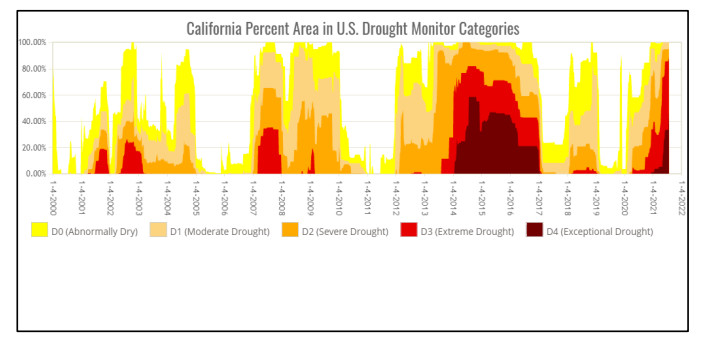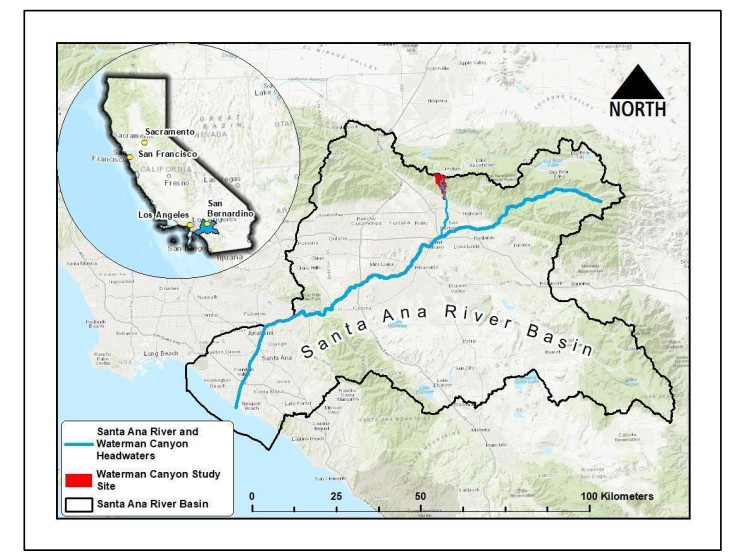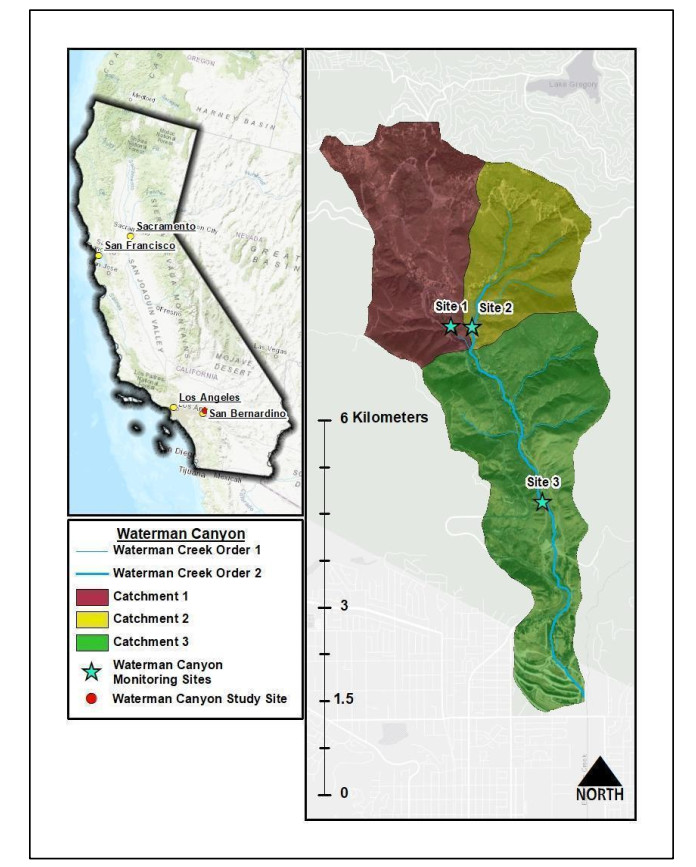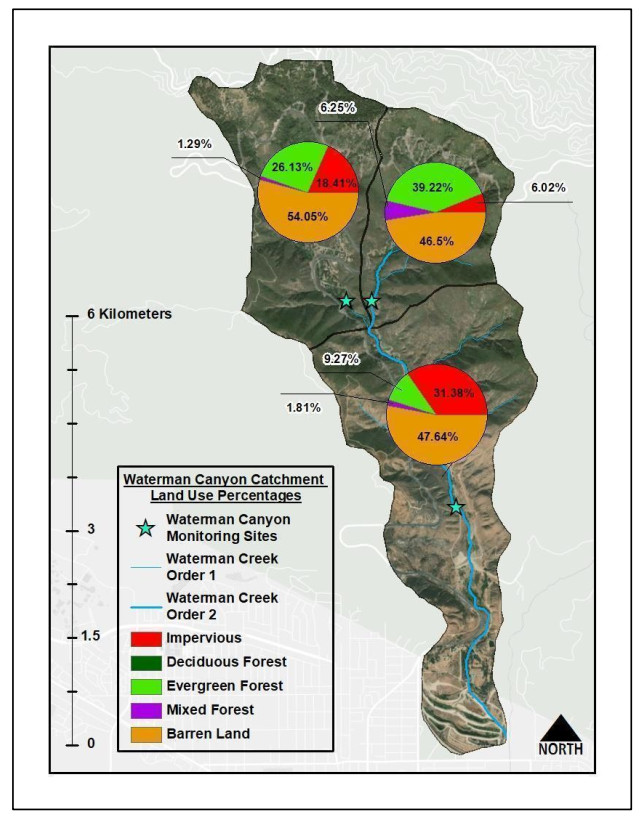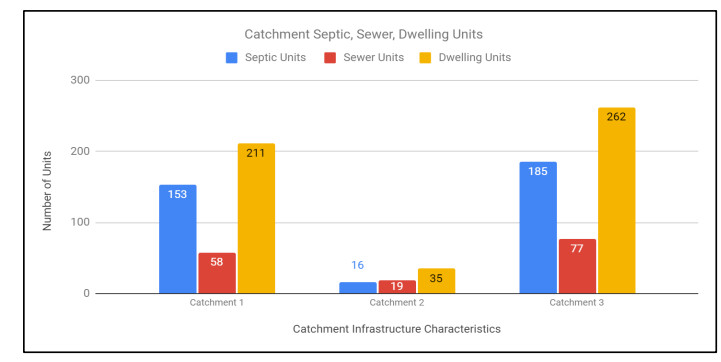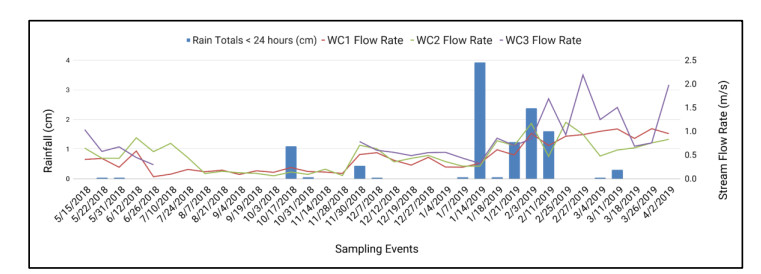1.
Introduction
Headwater stream impairments have primarily focused on urban, agricultural, and temperate forest landscapes while less attention has been placed on headwater streams (HWS) in semi-arid regions where water resources are limited [1,2,3,4,5]. Headwater streams serve as the beginning and collectively the largest percentage of stream miles across the hydrologic network (i.e. watershed or basin), providing numerous site and downstream human and environmental benefits [6,7,8,9,10]. Like other reaches of the hydrological network, HWS are adversely impacted by variable and spatially diverse human activities (e.g. deforestation, agriculture, development), natural activities (i.e. erosion) and hazards (e.g. droughts, fires, debris flows). Unlike other reaches of the hydrological network, when these activities occur in HWS they may create spatially diverse hydrologic impairments across the entire network as inputs move to downstream rivers, lakes and oceans. [11,12,13,14,15]. In semi-arid regions, water resources are becoming increasingly limited due to infrequent seasonal precipitation coupled with increasing drought conditions that significantly reduce the surface and groundwater resources needed to support human and environmental activities [16,17]. Despite the significance and recognition of HWS in influencing watershed and downstream water resources, the United States Clean Water Act (CWA) (Section 404) does not require monitoring of these streams creating knowledge gaps for public land (i.e. Forest and Park Services) and water agencies tasked with ensuring that water is available and safe for public and ecological uses [18,19,20]. Developing avenues to increase knowledge about the quality and quantity of HWS flows is essential to understanding the extent to which human and environmental activities can be sustained throughout the hydrological network (i.e. watersheds, river basins).
Across the United States, HWS account for 53 percent of total stream miles, supplying water for more than one-third of the population (i.e. ~117 million), however, only 19 percent of streams have been assessed to date. Although a majority of HWS are intermittent (i.e. seasonal flow) or ephemeral (i.e. flow during precipitation), a smaller number of perennial (i.e. year-round flow) streams represent the interface between wet (i.e. precipitation fed) and dry season base flows (i.e. groundwater fed) that supply surface flows year round [21,22]. Headwaters also play a vital role in supporting biodiversity by providing water along wildlife corridors, riparian vegetation, wetlands, fisheries while simultaneously supporting numerous natural resource-based economies including industrial, agricultural and residential uses [6]. Within semi-arid landscapes of the southwestern United States, such as California and Arizona, headwater streams are often located within public lands traversing steep terrain including the Sierra Nevada, San Bernardino, San Gabriel mountains and the Colorado Plateau [23,24,25]. During wet seasons (i.e. winter, spring), short but intense precipitation events (i.e. atmospheric rivers) provide a majority of the annual rainfall. In contrast, dry seasons (i.e. summer, fall) are characterized by low humidity, high atmospheric temperatures and extreme wind conditions that reduce soil and vegetative moisture and stream base flows supporting conditions conducive for wildfires [26,27,28,29,30]. Additionally, the emergence of prolonged drought conditions means that perennial headwater streams are often the only flowing surface water feature across these landscapes, but drought conditions are increasingly threatening their presence [31,32].
Adequate monitoring of headwater streams presents an opportunity for water resource and public land agencies and communities to identify water resource variability in relation to landscape characteristics, human activities and changes during climatic shifts (i.e. precipitations vs. drought events) [16]. Sources of pollution inputs may include nutrients, such as nitrogen, ammonium, phosphorus, bacteria (i.e. E. coli, coliforms), and dissolved solids that are conveyed to waterways and downstream during precipitation events, becoming increasingly concentrated during droughts when water levels are lowered [33,34,35]. Nutrients and bacterial inputs are of increasing concern because of their ability to support the growth of algal blooms that render waters toxic (i.e. harmful algal blooms) for wildlife and human contact or consumption. Potential sources of nutrients include wastewater (i.e. septic or sewer, livestock waste), fertilizers, and plant and animal decomposition [36,37,38,39,40]. High levels of conductivity and total dissolved solids (TDS) (i.e. inorganic dissolved solids) deriving from natural sources (i.e. rocks, soils erosion) and variable human activities include fertilizers, salt to melt ice and snow, and chemicals utilized in wastewater treatment infrastructure also contribute to the impairment of waterways [41,42]. A primary challenge in managing water resources is that inputs entering and residing in waterways often occur in tandem, creating longitudinal hydrologic impacts at the pollution source and downstream. Without sufficient monitoring of headwater streams, it will be increasingly difficult for resource agencies and communities to predict and mitigate impacts on water resources across the entire hydrologic network, especially in arid regions where water resources are becoming increasingly scarce [2,11,43,44,45].
2.
Materials and methods
2.1. Water resource and drought: a California case study
The state of California in the United States is one example of a region experiencing highly variable water resource management challenges. California has been at the epicenter of frequent and intense droughts that have reduced wet season snow and rainfall necessary for the recharge of surface and groundwater resources (Figure 1). However,by July 2021,100 percent of the state was in drought,with 89 percent of the state being categorized as extreme or exceptional drought conditions (Figure 2) [50,51]. Atmospheric rivers are long and narrow flowing columns of condensed water vapor that can transport large quantities of water in forms of rain and snow from the Pacific Ocean into the western United States [26,27,28,29]. Although beneficial, brief atmospheric rivers and precipitation events typically do little to mitigate reductions in the quality and quantity of water resources from years of drought forcing municipal, industrial, and agricultural sectors across the state to draw groundwater at rates that exceed recharge [52,53,54]. The lack of adequate monitoring of headwater streams coupled with California's frequent drought conditions further complicate implementing resilient water resource management strategies. A primary cause has been the knowledge gaps that link how upstream factors contribute to downstream challenges including groundwater retention, land subsidence, habitat loss, and reductions in the quality and quantity of water resources [55,56,57].
In the Santa Ana River Basin, the largest and most populated river basin in Southern California, HWS are located in the forested landscape of the San Bernardino National Forests traversing through downstream urban and rural landscapes supporting surface and groundwater flows. Nutrients from urban and agricultural runoff entering water resources, coupled with rapid development, population growth and prolonged drought conditions have been well documented as primary factors reducing water quality and quantity along the mainstem; however, headwater stream monitoring remains limited [25,58,59]. Such conditions have resulted in the widespread presence of harmful algal blooms (HABs) within streams and reservoirs that serve as primary drinking, recreational and habitat across the state by lowering dissolved oxygen, reducing aquatic diversity and the quantity and quality of water available for human use [60,61,62]. To mitigate water shortages in this semi-arid environment, seasonal snowmelt from the Sierra-Nevada mountains in Northern California is transported to the south to sustain increasing demands. However, allocations of water resources to Southern California have been reduced because of the lack of precipitation in Northern California [58]. In an effort to mitigate these shortfalls, the California State Water Board (SWB) and Department of Water Resources (DWR) expanded efforts beyond the CWA, the state's Porter-Cologne Water Quality Act and the California Water Quality Act to develop regional water resource management strategies beginning in 2002 with the Regional Water Management Planning Act (i.e. SB1672) and expanded in 2014 to include the Sustainable Groundwater Management Act (SGMA) (i.e. AB1739; SB1319; SB1168) [19,25]. Conditions regulated under this act include reduction in streamflow due to changes in groundwater/surface-water interaction and a directive for local water agencies to develop local-scale adaptive management strategies to ensure the efficient use of limited water resources. Nevertheless, headwater streams are rarely included in watershed monitoring and despite legislative efforts, regulatory hydrology and agencies continue to struggle with meeting highly variable water demands [63,64]. The lack of inclusion of headwaters in regulatory measures resulted in multiple California agencies and institutions, including the Association of California Water Agencies and the Public Policy Institute, to advocate for headwater protection and management. To date, the SWB has only issued suggestions for water managers to protect upstream flows with no issuance of a direct policy or mandate to monitor headwater streams [65,66,67,68].
Barriers to implementing headwater monitoring programs in the Upper Santa Ana River Basin, include complexities within adequate funding and staffing, jurisdictional limitations, as well as the physical difficulty (i.e. steep slopes, remote areas) and permission to access sites (i.e. National Forests, Parks, Private Land) [69,70]. As a contribution to understand the human and environmental factors influencing headwater quality and to raise awareness on the value of including HWS in water resources management planning in semi-arid headwater streams, this study aims to provide a case study example to (1) determine the extent to which seasonal climatic patterns (i.e. dry vs. wet) coupled with prolonged drought conditions influence the physicochemical characteristics of headwater streams and (2) illustrate statistically significant relationships between physicochemical characteristics and to (3) identify seasonal trends in meeting regulatory standards as well as the extent to which parameter concentrations exceed regulatory thresholds. Findings may assist with identification of specific best management practices (i.e. land management, policy, education, collaborations) that could support resource agencies across southern California, and similar semi-arid regions, with understanding the benefits of frequent monitoring of headwater streams. This collective knowledge provides a framework where hydrologically comprehensive and resilient policies aimed at protecting water resources from the headwaters to downstream waterways may be recognized and resolved.
2.2. Study site
Located within the San Bernardino National Forest, Waterman Canyon Creek (i.e. Waterman Creek) is a headwater stream of the Santa Ana River Basin, the largest and most populated river basin in Southern California (Figure 3). Catchment characteristics include forest and barren land, agricultural activities, commercial and residential buildings, impervious surfaces (i.e. roads, parking lots) and related infrastructure (i.e. septic and sanitary sewer systems, natural gas pipelines). Site geology is composed of young alluvial fan deposits, gneiss bedrock and landslide deposits consisting of a mixture of high and low permeability and low porosity [71]. Steep elevation gradients (i.e. 305 m to 1,433 m) created by tectonic activity (i.e. San Andreas fault) supports orographic lifting resulting in higher annual precipitation (i.e. 89 cm rain, 94 cm snow) when compared to the surrounding valley (i.e. 33 cm) landscape. The Mediterranean climate (i.e. semi-arid, arid, B-climates) means that precipitation typically occurs during the late fall, winter and early spring with October to April experiencing the highest precipitation during the hydrological year [58,72,73]. Downstream of the sampling locations, Waterman Creek supports numerous human and ecological activities including contributions to the San Bernardino Valley Municipal Water District's groundwater percolation basin that provides water resources to communities in the cities of San Bernardino and Rialto [74]. Access to the HWS can be limited in this region due to steep terrains, partition boundaries (i.e. jurisdictional, private) and restoration efforts leaving a limited number of stream access points reliant on private landowner consent. Study monitoring sites represent two perennial headwater streams (i.e. Catchment 1, WC1, HUC 22554838, 4.66 km2; Catchment 2, WC2, HUC 22554836, 3.13 km2) and a downstream confluence creating the mainstem of waterman creek (i.e. Catchment 3, WC3, HUC 22555344, 7.28 km2). Catchment 3 represents both the collective drainage areas of the study site (i.e. catchments 1 and 2) and the closest available access point prior to surface and subsurface flows entering the San Bernardino Valley Municipal Water District's groundwater percolation basin (Figure 4). Downstream, Waterman Canyon primarily flows subsurface (i.e. groundwater), resurfacing in Riverside as a contribution to the surface flows of the Santa Ana River. This flow provides numerous recreational, ecological and drinking water resources before terminating at the Pacific Ocean near Huntington and Newport Beaches [75,76,77].
2.3. Catchment landscape, hydrologic and climatic characteristics
Catchment drainage area boundaries and hydrologic characteristics were determined using the EPA's WATERS KMZ geospatial layer imported into both ArcGIS 10.4 and Google Earth for analysis [74]. Land use types were identified by importing the 2016 Multiresolution National Land Cover Dataset (MRLC) 30m raster file into ArcGIS 10.4 [78]. This raster file was clipped to the catchment areas and Google Earth's satellite imagery were utilized to identify the percent of each land use types within a catchment. Precipitation data points were collected from Weather Underground using the Upper Waterman Canyon and Mountain weather stations, located upstream from the testing sites [79]. Rainfall accumulations (cm) were aggregated for 24 hours prior to a single sampling event. Additionally, septic and sewer (i.e. separate sanitary sewers) information was collected from the San Bernardino Valley Municipal Water District and the Crestline Sanitation District [10,80,81].
2.4. Water quality sampling
Water quality was monitored in situ from May 2018 to April 2019 for each site (i.e. WC1, WC2, WC3) for conductivity (μS/cm), dissolved oxygen (DO, mg/L), stream flow rate (m/s), pH, and stream temperature (℃) using Venier's sensors and probes and a Vernier Labquest 2 monitor similar to Abu-Baker et al. (2016) [82], Khatoon et al. (2013) [83], Vega et al. (1998) [84], and Varol et al. (2012) [85]. Ammonium (NH4+, mg/L), nitrate (NO3-, mg/L), and turbidity (NTU) were monitored similarly using Vernier's sensors and probes. Additional grab samples were collected, immediately placed on ice, and transported to California State University at San Bernardino to test for total Coliform (TC, cfu/100mL), Escherichia Coli (E. coli, cfu/100mL) and total dissolved solids (TDS, mg/L). Total Coliform and E. coli were analyzed using U.S. EPA approved IDEXX methods, Colilert, Colilert-18, Colisure, and Quanti-Tray/2000 and reported to the 95% confidence interval (Table 1). Using these methods, results are reported as the most probable number (MPN), which aligns with the EPA's colony forming units (CFU) units. Grab samples were collected in 1 (L) brown opaque HDPE plastic bottles that were acid washed using EPA protocols (Table 1) [86]. Sample events occurred at each site bi-weekly during the dry season (i.e. May to September 2018) and weekly during the wet season (i.e. October 2018 to April 2019) with increasing sampling with 24 hours of precipitation events to identify physicochemical and surface flow rate trends related to climatic and seasonal changes. Individual sampling events and seasonal trends were compared to federal, state, and regional water quality objectives and standards to determine the seasonal frequency in which samples met or exceeded these requirements (Table 2) as well as to determine the percent increase in sample concentrations over the highest regulatory thresholds.
2.5. Statistical analysis
Applying methods similar to Alford et al. (2016) [11], Khatoon (2013) [83], and Varol et al. (2012) [85], descriptive statistics for each water quality parameter were calculated for each sampling site. Parameters were tested for normality with SPSSv24 using Shapiro-Wilks tests, skewness, and kurtosis. Parameter data not following a normal distribution was transformed using a natural log transformation in Microsoft Excel as previously applied by Mallin et al. (2016) [92], USGS (2019) [93] and Yuncong and Migliaccio (2011) [94]. SPSSv24 was used to create Pearson's correlation matrix to understand the strength of statistically significant relationships between water quality parameters. Additionally, time series analysis was conducted using Microsoft Excel to observe changes in the physicochemical characteristics of sampling sites during drought and precipitation conditions (i.e. rainfall, snowmelt, snow and fog).
3.
Results and discussion
3.1. Catchment landscape and climatic characteristics
Previous studies highlight the need to understand watershed landscape features, climatic patterns and their associations with various water quality impairments [13,95,96]. In this study, barren land (i.e. 46%+) represented a majority of the land use types across all three catchments (Figure 5) with evergreen, impervious surfaces and mixed forest accounting for other land types. Across two tributary drainage areas, catchment 1 (i.e. WC1) represents a majority of barren land (i.e. 54%+), catchment 2 (i.e. WC2) represents the highest percentage of evergreen forests (i.e. 39%+), while catchment 3 (i.e. WC3), represents the collective landscape and downstream areas from catchments 1 and 2, having the highest percentage of impervious surfaces (i.e. 31%+; roads, houses). When considering the developed features of these tributaries, catchment 1 (i.e. WC1) had the highest number of dwelling units (i.e. 211), and related septic (i.e. 153) and sewer (i.e. 58) systems, while catchment 2 had the second highest number of these features with more agricultural features (i.e. crops, livestock) and less impervious surfaces (Figure 6).
Observed precipitation trends (Figure 7) illustrate a pronounced distinction between dry (i.e. May to September 2018) and wet (i.e. October 2018 to March 2019) which included drip fog, rainfall and upper watershed snowmelt that collectively contributed to increases in stream flow conditions. The wet season includes multiple atmospheric rivers [97] with April signifying a transition back into the dry season. Dry conditions resulted in lower stream flows represented by groundwater fed surface base flows across all three sampling sites with WC3 having no surface flows from June 26 to November 28. The Mediterranean climate of the region coupled with multiple years of drought likely contributed to these conditions and are similar to those observed by Winter (2007) [98], Avanzi et al. [99] (2020) and others. Although smaller precipitation events (i.e. drip fog and rainfall) occurred in May (i.e. 0.02 cm) at the beginning of the study period, October represents the first significant rainfall event (i.e. 1.14cm), followed by increasing rainfall accumulations throughout January (i.e. ⅀5.27 cm) and February (⅀3.98 cm). Cumulative precipitation events contributed to the highest observed stream flows across all three sites with elevated flows present in the days and weeks after rainfall and upper elevation snowmelt. Similar to these study sites, landscapes void of vegetation (i.e. barren land, impervious surfaces, agricultural landscape) coupled with steep topography, extreme elevation changes, and intense but brief precipitation events have been observed to create variability between precipitation event occurrences and their influence on stream flows [43,44,100,101]. For example, in this study, it was observed that rainfall events occurring within 24 hours near sampling locations increased stream flows related to storm and overland flows. Additionally, due to the steep topography and extreme elevation changes from the upper to lower portions of the watershed, snowfall was often present in the upper watershed from January to early March. With warming temperatures occurring across the watershed in early February through March, snowmelt runoff increases stream flows as water drained from the upper watershed to the lower watershed where sampling sites are located.
3.2. Quantifying headwater stream characteristics, regulatory exceedances, and seasonal trends
Descriptive statistics highlight relevant physicochemical characteristics during the study period (Table 3) with seasonal regulatory exceedances across sampling events highlighted in figures 8 and 9. Observations include the high variability (i.e. variance) of total coliform (TC), E. coli, conductivity, and total dissolved solids (TDS). Parameter means for NO3- and TDS exceed regulatory standards across all sites, with TC means only exceeding for WC1 and WC2. Although beneficial, the means mask seasonal trends in exceedances observed during the study period. For example, trends for nutrients (NO3-, NH4+), TC and TDS reveal that these parameters consistently exceeded regulatory standards during both seasons with the dry season representing the highest exceedances for NH4+, TC and TDS (Figures 8 and 9). In contrast, the wet season represented the highest exceedances for NO3- across all sites, however, there was only a marginal increase in NO3- concentrations between seasons at WC1 and WC2. One stark contrast between seasons occurs at WC3, where there is a 75 percent increase in the number of samples exceeding regulatory standards between the dry (25%) and wet seasons (100%) with NH4+ concentrations ranging from 100 percent of samples exceeding during the dry seasons and 42 percent exceeding in the wet season. These trends are likely due to the absence of flows creating the inability to sample during the summer and early fall months. Other seasonal trends in impairments include TDS, which exceeded standards 100 percent of the sampling events during the dry season and 72 to 88 percent of sampling events in the wet season across all sites. Collectively, these trends illustrate that on average nutrients (NO3-; NH4+), TC and TDS are exceeding regulatory standards throughout the study period and across all sites. Consequently, these exceedances often occur simultaneously, suggesting potential short- and long-term impairments to water residing in the HWS that contribute to downstream water resources.
Variability in precipitation patterns also resulted in dynamic fluctuations in parameter concentrations throughout the study period. For instance, when dry weather persisted in September, base flow conditions at WC1 resulted in NO3- samples that were 16 to 72 percent higher than the regulatory standard, with WC2 concentrations ranging from 36 to 40 percent higher than regulatory standards. Sampling for NH4+ met the regulatory standards at WC1 for both sampling periods with WC2 only meeting this requirement during the second sampling event. Total coliform (TC) concentration trends for September revealed that while WC1 maintained high concentrations of TC (142%) for sampling events, WC2 was 20 percent higher during the first sampling event, meeting regulatory standards in the second sampling period. Additionally, trends for TDS illustrate an increase in concentrations across both WC1 (25%, 43%) and WC2 (38%, 40%) revealing that multiple parameters are excessively higher than regulatory thresholds simultaneously.
During the wet season, January represented the highest accumulation of precipitation events (⅀5.27 cm) with the most significant increase in NO3- concentrations occurring in the second half of the month (i.e. WC1 1,504%, WC2 700%, and WC3 644%). In contrast, the highest observed NH4+ concentrations occurred during the first half of the month prior to significant rainfall, ranging from 1,875% (WC2) to 2,575% (WC1) above regulatory standards. With increasing rain accumulations NH4+ concentrations decreased, with all sites meeting regulatory standards by the end of the month, at a time when NO3- concentrations were increasing suggesting that both natural (i.e. nitrification) and anthropogenic (i.e. landscape features) process may be attributing to nutrient concentration shifts. Trends in TC concentrations revealed that during early sampling events all sites met regulatory standards, yet during the second half of the month, TC concentrations ranged from 55% to 142% above standards across all sites, with all sites meeting regulatory standards indicating a possible dilution of TC concentrations with increasing flows. Furthermore, TDS concentrations were 22 percent to 188 percent above the regulatory standards with the highest concentrations occurring at WC1 during the third sampling period (104%), WC2 during the first sampling period (74%), and WC3 during the second sampling period (181%). Although these examples are a snapshot of the overall observations, they help to reveal dynamic processes across the study area even in short periods of time. Understanding this rapid flux in parameter concentrations supports the implementation of management strategies that target specific catchment water quality characteristics across wet and dry seasons. The extreme shifts in parameter concentrations and variability across diverse tributary catchment landscapes observed during this study are similar to those found in numerous studies where both seasonality and sources of pollution inputs can be highly variable leading to rapid variability of pollution inputs associated with both stormwater flows and dry seasonal stream characteristics [102,103,104].
3.3. Physicochemical parameter correlations
Physiochemical correlations were calculated to understand the strength of relationships among observed parameters. Several trends emerged across all sites including inverse relationships between stream temperature and DO, TDS and DO and TDS and stream flows. (Tables 4 and 5). The relationships between DO and stream temperatures are expected because the level of DO concentrations are directly associated with stream temperature, with increasing temperatures reducing DO levels and cooler temperatures increasing DO levels [105]. In contrast, stream temperature was positively correlated with TDS, while TDS was negatively correlated with stream flow across all three sites. These relationships illustrate that in warmer months when stream flows were lower and stream temperatures were warmer, there were higher concentrations of TDS. TDS can be elevated by both natural and human sources including geological erosion and effluent from wastewater and agricultural production, all of which are present throughout the study area. When observing trends in nutrients (i.e. NO3- and NH4+) and bacteria (i.e. TC, E. coli), higher concentrations of NO3- were positively associated with stream flow and DO, however, the parameter was negatively associated with stream temperature and conductivity at WC1 and WC2. Other nutrient observations include NH4+ positive associated with conductivity at WC1 and WC2, while NO3- was positively associated with DO across all three sites. Additionally, (TC) was positively associated with stream temperature and conductivity at WC1 and WC3, however it was negatively associated with stream flow, DO and NO3- only at site WC1. Both WC1 and WC2 illustrated positive associations between E. coli, stream temperature and conductivity. One significant difference in E. coli relationships with other parameters was its negative association with stream flow and DO, which only occurred at WC1. Overall observations in nutrient and bacterial concentrations indicate that during higher stream flows, NO3- may be more present in the water column as it is moved from the landscape to surface water features, and it has the potential for nitrification in streams. As flows decrease and increasing water temperatures persist, pollution inputs present in the water column may become more concentrated and decomposition activities may increase NH4+, illustrating potential human-environmentally driven nutrient processes present during both dry and wet seasons [106]. Similar trends observed in the correlation matrix are reflected in seasonal trends of parameter exceedances (Figures 8 and 9).
Nutrients, bacteria, and TDS are of concern across the study site and are of increasing concern in surface and groundwater resources globally. Potential anthropogenic point and nonpoint sources that contribute to excessive parameter concentrations in surface waters include animal waste and plant and animal decomposition, as well as effluent from wastewater systems and the application of fertilizer on the landscape as observed by Barakat et al. (2016) [36], Carpenter (1998) [107], Tong and Chen (2002) [5] and others. Although it was beyond the scope of this study to directly trace pollution input sources, it was observed that in relation to the two tributary catchments (i.e. WC1 and WC2) WC1 has the highest number of dwelling units with septic and sewer infrastructure coupled with high percentages of impervious surface and barren land types. These catchment characteristics are conducive to transporting pollution inputs to nearby streams during rain and snowmelt events as well as having a higher potential occurrence of septic and sewer system failures (i.e. leaks) that may be contributing to consistently elevated nutrients, TC, and TDS within the tributary catchment and downstream year round. Also observed was the excessive presence of these parameters in WC2. In contrast to WC1, this tributary catchment landscape represents less impervious surfaces, however, with the inclusion of agricultural food and livestock activities, this landscape illustrates more potential sources of parameter inputs entering the tributary stream.
Excessive nutrients in the water column cause reductions in dissolved oxygen levels (i.e. hypoxic conditions) that threaten aquatic species and human health [37,39,40]. In rural areas, excessive nitrates have been observed in wells that are generally linked to agricultural activities, leading to cancer and drastic reductions in hemoglobin, reducing oxygen levels in adults and infants (i.e. blue baby syndrome) [38,108]. These findings support other studies such as Mosely (2015) [109], who synthesized over a decade of drought-related water quality studies across variable hydrologic features (i.e. lakes, rivers, streams) observing that drought conditions characterized by high atmospheric temperatures and low flows often increased salinity, turbidity, nutrients and algal production. Across various geographical scales, driving factors of these conditions were linked to the reduced amount of water that dilutes pollution inputs associated with human-environmental sources such as failing septic and sewer systems and impervious surfaces. Collectively, excess of all observed parameters can reduce aquatic biodiversity and human health, which is of special concern during drought conditions when water resources are in high demand [36,41,42]. Contributing to this growing knowledge, this study also highlights the role of brief atmospheric rivers and wet seasonality characterizing semi-arid landscapes in transporting pollution inputs to surface water resources indicating a need for frequent, year-round monitoring to determine flux conditions of specific inputs as well as how multiple parameters exceed regulatory standards simultaneously.
This approach to illustrating relationships may further assist resource agencies with identifying appropriate management strategies, such as stormwater best management practices (BMPs) to explore how targeting one parameter may lead to the reduction of other correlated parameters as suggested by Barret (2005) [110], Commings et al. (2000) [111], Khatoon et al. (2013) [83], Mallin et al. (2016) [92], Roy et al. (2014) [112] and others. Headwater streams provide an opportunity to spatially isolate these relationships within the hydrologic network so that BMPs can target impairments specific to each catchment to further minimize downstream impacts. It should also be noted that although there are inverse relationships among many of the parameters, it does not dismiss previous findings that even in these cases, many of these parameters are exceeding regulatory standards. These statistically significant relationships support findings reported by Ice and Sugden (2003) [113], Van Vliet and Zwolsman (2008) [114] and others when observing stream quality during similar climatic patterns.
3.4. Mitigating chronic headwater stream impairments: multi-tiered strategies and collaborations
Despite being omitted from a majority of watershed and resource planning, this study magnifies the value of including headwater streams (HWS) in such processes to ensure hydrological inclusiveness and management across the entire network (i.e. basin, watershed). This is increasingly necessary in semi-arid regions characterized by limited water resources and increasing human populations that continue to experience climatic shifts related to prolonged drought and overall decreases in precipitation during the wet seasons. This study observed highly variable concentrations of nutrients, bacteria, conductivity, and TDS that were higher than regulatory standards throughout the study period. Although often exceeding regulatory thresholds, across all sites, lower values of NO3- were observed during drier periods, when NH4+, TC and TDS were at their highest values during the study period. As previously noted, NO3- increased after rain events, while NH4+, TC, and TDS decreased. The fluctuation in parameter concentrations observed during the wet and dry seasons, suggests that both climatic and watershed landscape factors are contributing to increased pollution inputs in waterways, similar to trends also observed by Barakat et al. (2016) [36], Corsi et al. (2010) [41], Kaushal et al. (2005) [42], Tong and Chen (2002) [5], and others. Since these impairments are occurring simultaneously, it creates a complex array of water quality and quantity issues that require resource managers to tackle pollution input reductions across multiple parameters and sources. Furthermore, results suggest that the exclusion of HWS in watershed and water resource planning initiatives is a critical gap in effectively identifying and mitigating surface water impairments across a hydrological network.
To reduce pollution inputs throughout the hydrological network, resource managers should consider an array of mitigation strategies including the monitoring of watershed infrastructure (i.e. septic, sewer, impervious surfaces) and streams, the implementation of best management strategies, community-agency collaborations, and education and outreach programs that support a comprehensive approach using both regulatory and non-regulatory approaches [115]. One example of a multi-tiered field monitoring and BMP approach is the United States Forest Service's (USFS) attempt to understand the extent to which watershed features (i.e. undisturbed vs. disturbed) across a forested landscape are influenced by sediment loads in streams. The strategy incorporates sediment fences, bank pins, turbidity measurements to identify sources of sediment loads in streams and the extent to which loads are influenced by both precipitation events and the types of pollution inputs entering stream systems through sediment transportation. This multi-tiered approach has enabled the USFS to target specific stream segments within the watershed as well as mitigating multiple pollution inputs (i.e. bacteria, nutrients) through a single BMP structure. This approach further enables the USFS to focus limited resources on resolving issues unique to that specific watershed versus applying the more traditional "one size fits all" BMP approach [116].
Also central to a multi-tiered monitoring approach to watershed management is identifying and managing the diverse human and environmental activities across the entire hydrological network through a collaborative planning and management framework. Emerging research suggests common pool resource (CPR) and adaptive management approaches are more inclusive strategies aimed at achieving water resiliency in uncertain conditions, especially across the surface-groundwater interface [115,117,118]. For example, Kiparsky et al. (2017) [63] suggest that although much legislation, including the California's Sustainable Groundwater Management Act, provides an "ideal" if idealistic framework whereby local agencies are required to self-organize to resolve water resource issues, such an approach presents numerous challenges for a single agency to tackle. To bridge agency needs through community engagement, Kiparsky et al. (2017) [63] present an approach that includes establishing a framework (i.e. identification of stakeholders, resources, etc.) through two overarching criteria: Efficacy Criteria which includes (1) scale (i.e. extent of regulatory oversight and spatiality of resources), (2) human capacity (i.e. knowledge of institutions and community; monitoring), (3) funding, (4) authority (i.e. cross jurisdictional boundaries), (5) independence and the Fairness Criteria (1) participation (i.e. institutional and community), (2) bottom up representation starting with stakeholders to inform decision makers, (3) accountability that includes agency responsibility for decisions, and (4) transparency across all stakeholders and agencies.
When applying this framework to this study site, there are numerous opportunities to develop a process by which decision makers are informed by stakeholders through frequent field monitoring and communication that prioritizes data centric assessments of water resources, and landowner knowledge to develop a more targeted and specific multi-tiered approach to managing water resources across the human-environment interface. For example, the study site traverses multiple jurisdictional boundaries including USFS, San Bernardino Valley Municipal Water District (SBVMWD) and private landowners, serving as a resource for commercial, residential, and industrial activities, while providing essential and often limited water resources for ecological habitat and numerous endangered species in situ and downstream. Expanding monitoring efforts to include HWS and participation by landowners is one available strategy, but to fully realize a more resilient management approach, HWS data can bridge knowledge gaps about the type, source and frequency of pollution inputs entering these waterways. This allows specific BMPs to be developed and strategically placed within the watershed to mitigate significant influxes of multiple pollution inputs to streams occurring simultaneously. Slough et al. (2021) [119] suggesting that community-based monitoring enables community members to both gain and share knowledge creating opportunities that support a more comprehensive bottom-up decision making model, instead of traditional top-down structure. Additionally, it helps to reduce human resource strains within agencies, while also helping agencies to become more transparent and engaged with the communities they serve. Such approaches would be beneficial, especially in semi-arid regions that experience increasingly diverse challenges in maintaining and protecting HWS flows. As a result, utilizing HWS knowledge can inform stakeholders in situ and downstream to develop more comprehensive policies that are inclusive of factors contributing to water quality and quantity throughout the entire hydrological network, enabling communities to become more resilient for current and future generations.
4.
Conclusions
Documenting the climatic impacts on the physicochemical characteristics of surface water quality in headwater streams is necessary to effectively determine the extent to which headwater streams may be influencing water resources throughout the entire hydrologic network. This study illustrated dynamic variability in physicochemical concentrations within headwater streams related to landscape features and climatic conditions. This is of concern because, like many other semi-arid regions, this basin is used to provide water resources to multiple communities located in an arid region experiencing chronic droughts coupled with increasing water resource needs to meet both human and environmental activities. As such, findings emphasize the importance and need for frequent, year-round water quality testing in perennial headwater streams since, collectively, these stream types cover the highest percentage of stream length across a given hydrological unit. It is recognized that monitoring alone cannot adequately support effective watershed management and the adoption of multi-tiered strategies (i.e. monitoring, BMP implementation, collaborations, education, landowner cooperation) because a long term process is ultimately needed to fully address the ever-changing barriers to ensuring water resources are adequate and protected.
Omission of headwater streams in watershed planning and water resource management limits knowledge about how upstream factors are spatially contributing to stream impairments that threaten water quality and quantity downstream and across the hydrological network. This potentially introduces enormous barriers to meeting regulatory standards and uncertainty related to financial costs to resource agencies charged with ensuring that water resources are available during drought conditions for current and future generations. Monitoring and assessment strategies implemented in this study can be applied globally to further expand knowledge and to underscore the importance of including headwater streams in assessments. Such inclusion supports sustainable resource management strategies that are hydrologically comprehensive. In doing so resource agencies and communities will be able to meet the ever-changing socio-economic needs and increasingly unpredictable and more volatile weather patterns that affect water quality and quantity.
Conflict of interest
The authors declare no conflict of interest.
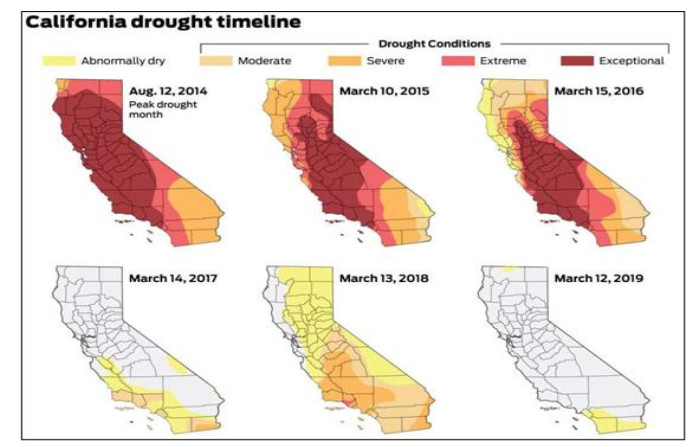









 DownLoad:
DownLoad:
